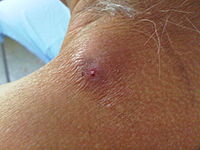
Photo from wikipedia
Background and Aim: Goats are reared for their meat, mohair and other socio-cultural needs in Lesotho. Helminth infections are some of the major setbacks in the goat production industry due… Click to show full abstract
Background and Aim: Goats are reared for their meat, mohair and other socio-cultural needs in Lesotho. Helminth infections are some of the major setbacks in the goat production industry due to their negative impact on animals’ health, resulting in significant losses on meat and mohair production and death. A cross-sectional study was conducted to determine the prevalence, fecal egg infestation, and morphological identification of gastrointestinal parasites in goats. Materials and Methods: Fecal samples were collected from 765 goats and subjected to McMaster egg counting techniques using the flotation method. Statistical analyses were performed using the Statistical Package for the Social Sciences (SPSS v.26.0). Results: The overall prevalence of gastrointestinal parasites was 94.7%, and the identified gastrointestinal parasites were nematodes (64.7%), coccidia (25.8%), and cestodes (4.2%). Haemonchus contortus was identified as the prevalent gastrointestinal nematode species found in goats. The prevalence and fecal egg count of gastrointestinal parasites were significantly higher (p<0.05) in goats located in the highlands and Senqu River Valley, while goats in the lowlands demonstrated a significantly (p<0.05) higher prevalence of H. contortus. Immature goats and kids were more significantly (p<0.05) prone to gastrointestinal parasites. Conclusion: The nematodes and coccidia infestations were prevalent in goats located in the highlands and foothills, respectively, whereas nematode and coccidia fecal egg loads were higher in goats located in the foothills and Senqu River Valley, respectively.
Journal Title: Veterinary World
Year Published: 2021
Link to full text (if available)
Share on Social Media: Sign Up to like & get
recommendations!